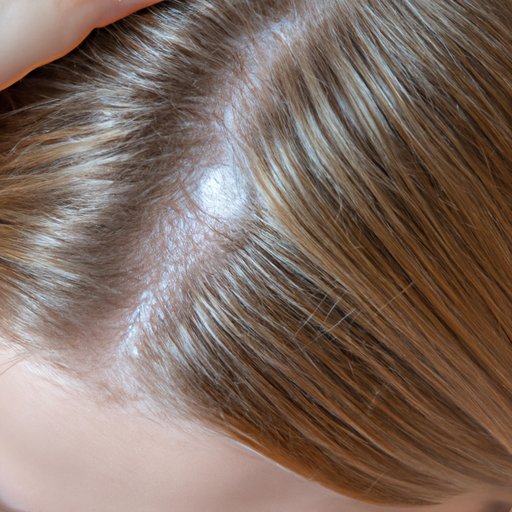
Introduction
Lice infestation is a common problem, especially in school-going children. It spreads easily from one person to another via hats, combs, and other personal belongings. If left untreated, lice infestation can lead to more severe scalp problems and other complications. Therefore, it’s crucial to identify and treat lice effectively. In this article, we will explore how you can check yourself for lice, including the symptoms to look out for, the step-by-step process for self-examination, safe and effective treatments, natural remedies, prevention tips, and when to seek professional help.
Understanding the Symptoms of Lice: A Comprehensive Guide
There are several symptoms of lice infestation, which you should look out for. Itching is the most common symptom, as the lice saliva can cause an allergic reaction leading to severe itching. You may also notice small red bumps or sores on your scalp, neck, and shoulders caused by scratching. If left untreated, this could lead to a bacterial infection. Hair lice are small wingless insects that are difficult to spot by the naked eye. However, if you notice tiny white or brown eggs attached to the hair shafts, you likely have lice. Nits are lice eggs that look like flakes of dandruff, but they can’t be easily removed by brushing or shaking hair.
Self-Examination for Lice: Easy Step-by-Step Guide
The best way to check yourself for lice is by combing your hair with a fine-toothed comb over a white towel. For even better results, use a magnifying glass to examine your scalp. Here’s a step-by-step guide on how to check yourself for lice effectively:
1. Wet your hair thoroughly and add a conditioner. This makes the comb glide easily through your hair.
2. Comb your hair in sections from the scalp to the tips of the hair. Cover all the areas, including the back of the ears and the nape of the neck.
3. Wipe the comb on the white towel after every combing to see any lice or nits.
4. Repeat the whole process until you go through all your hair.
5. To confirm if there are lice eggs, rub the hair strands against the towel to see if there are any brown dots.
The Do’s and Don’ts of Lice Treatment
There are some common myths and misconceptions about treating lice that you should avoid. For instance, using mayonnaise, olive oil, or petroleum jelly is not a proven way to treat lice infestation. Rather, you can use medicinal-grade products such as shampoos, lotions, or sprays specifically formulated to treat lice infestation. The active ingredients in these products often work by suffocating or killing lice and nits. Also, avoid using hair dryer since it might cause the lice to scatter to other parts of your head, and avoid sharing combs, towels, or other personal items with other people.
Home Remedies for Lice: Natural Treatments that Work
In addition to the professional-grade products, there are also several home remedies that have been proven effective to kill lice. These home remedies include tea tree oil, coconut oil, apple cider vinegar, and many others. Always do your research and make sure you do not have any allergies to any of these natural products before using them. Here are some helpful tips for using these natural remedies:
– Always dilute essential oils.
– Use a fine-toothed comb to remove the dead lice and nits.
– Wear a shower cap to help suffocate the lice.
– Repeat the treatment every three to four days.
Over the Counter Lice Treatment Products: A Comprehensive Review
Many over-the-counter products can help treat lice infestation, including shampoos, lotions, and sprays. You can buy these products without a prescription at any drugstore or online. Each product has different instructions for use and should be followed to the letter for the best results. Some of the most popular and effective products include Nix, RID, and LiceFreee!. It’s also important to know that after treatment, you need to continue combing your hair with a fine-tooth comb and check for any remaining lice or nits.
Preventing Lice: What to Do and What Not to Do
Preventing lice infestation altogether is the best solution. Here are some tips for avoiding lice:
– Avoid sharing personal belongings with other people.
– Do not use other people’s combs, hairbrushes, hats, or towels.
– Wear your hair up in a bun or ponytail when practical.
– Teach your children to avoid head-to-head contact while playing with others.
When to See a Doctor for Lice
If you experience severe itching or have any open sores on your scalp, you should seek professional help from your doctor. They will offer advice on the best way to treat the infestation and prescribe medication if needed. Also, if the lice treatments you have tried have not been successful, it’s crucial to seek professional help to prevent the spread of lice. Moreover, if you have a weakened immune system or a chronic skin condition, you should consult a physician before using any lice treatments to avoid any adverse reactions.
Conclusion
Learning how to check yourself for lice and prevent its spread can save you from several complications and discomfort. Self-examination is key if one wants to confirm the presence of lice. The recommended treatment is the over-the-counter products that are specifically formulated to eliminate the lice and nits. However, if any complication related to lice infestation arises, seeking professional help is important. Preventing the lice infestation is also important, and one can use the simple tips discussed above. By taking these measures and keeping your scalp and hair healthy, you can stay lice-free and prevent reinfestation.





